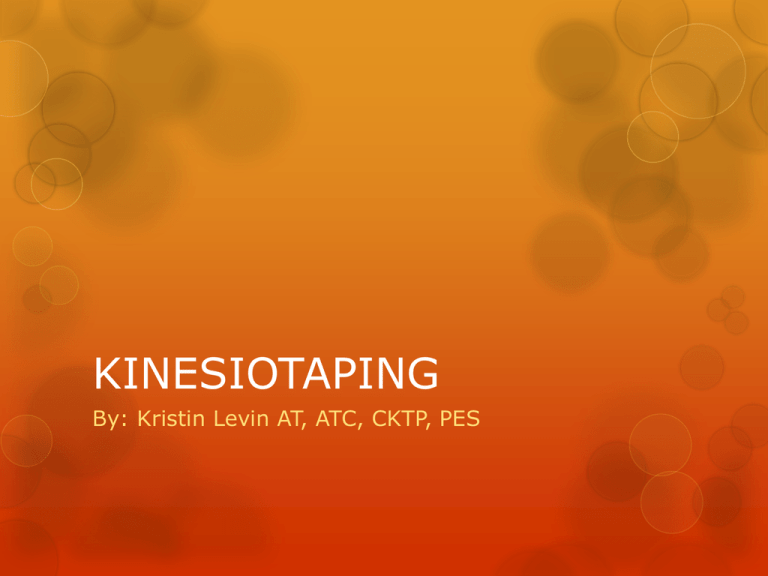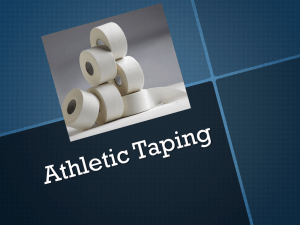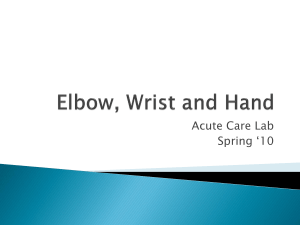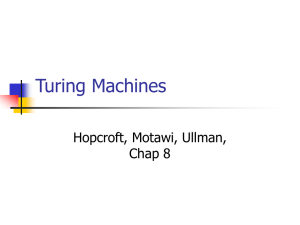KINESIOTAPING
advertisement

KINESIOTAPING By: Kristin Levin AT, ATC, CKTP, PES Objectives Identify what Kinesio tape is and what it is used for Indications and contraindications of the tape. The theory behind muscle tapings and lymphatic tapings. Corrective Taping Techniques. Applications and removal of the tape. Kinesio tape was developed in the early 1980s by Dr. Kenzo Kase. Depending on how you apply the kinesiotape it can work in different ways. It mimics the qualities of human skin. Being light and as flexible as the skin. This is to avoid the bodies perception of weight and avoids sensory stimuli. Kinesiotape works by subcutaneously lifting the skin. Enhances muscular, joint and circulatory function by facilitating a muscle, inhibiting a muscle, working with the lymph system to help with edema. Can be used in all phases of an injury acute, subacute and rehabilitative. General rules The tape can be worn 24 hours a day and left on for 3-5 days. You want to make sure the skin is free from lotion and oils for the tape to adhere properly. Can shower and ice over the area. Towel dry. DO NOT USE A HAIR BLOWER to the tape. Moist heat is ok but dry heat is not. Pull the tape off gently, do not yank like a band- aid. The Tape Non latex. 100% cotton with an acrylic heat activated adhesive. No medications Water resistant Has a stretch in the longitudinal direction only. Has about a 10-15 % stretch on the paper. Can stretch to 40-60% of its resting length The thickness and the weight are similar to the skin. Does not restrict ROM. There is no difference with the different color tapes. New FP tape •Lighter weight with a new weave process for improved comfort •Brings nano-touch micro-stimulation to epidermis and layers beneath; improved grip and lift •Higher grade cotton with increased breathability •Kinesio FP Tape is more forgiving to initial application errors; easier to reposition Precautions Diabetes Kidney disease Congestive heart failure CAD or Bruits in the carotid artery Fragile or healing skin ( milk of magnesia in elderly can be benificial) May need MD clearance to tape if these conditions are present Contraindications Over an active malignancy site Over active cellulitis or skin infection Open wounds Deep vein thrombosis Practice tearing the paper and seeing the elasticity of the tape. Also note the differences between the two tapes. Physiological effects Skin Circulatory/ Lymph system Fascia Muscle Joint Skin The body is made up of 3 layers: the endodoerm, mesoderm and the ectoderm. Because all three layers are interconnected, Kinesiotape can treat the entire body from the outside in. Kinesiotape effects the sensors of the skin through its application process. Through the manipulation of these sensors the kinesiotape can change the healing processes of the body. Kinesiotape can reduce pain by alleviating pressure on the neural and sensory receptors and reduce swelling by increasing fluid movement. Circulatory/ Lymphatic System Kinesiotape can speed lymphatic drainage and flow by increasing the amount of space beneath the skin, creating a more efficient exchange of lymph and bodily fluids between different tissues. Reduces edema Equalizes temperature The tape lifting the skin causes convolutions which creates a channel of low pressure in the congested areas. Decreases pain Fascia Fascia is fibrous and a connective tissue. With all the layers of fascia connected, by taping the skin it can effect the deepest layer of fascia. Collagen or fat exists between each layer of skin. If the person is not moving sufficiently the collagen may act as glue and adhere the surfaces together. Muscle By understanding the science of muscle movement one can better envision the way that kinesiotape will effect the muscles function. Must evaluate and decided if pain is coming from a muscle weakness or a tightness and tape accordingly. Kinesiotape can relieve muscle pain, increase ROM, normalize length/tension ratios to create optimal force, assist with tissue recovery and reduce fatigue. Joint Can improve joint alignment and biomechanics Facilitate ligament and tendon function Enhance kinesthetic awareness. Correct muscle imbalance Getting ready to tape Different tape cuts for different body parts and applications I strip Y stip X cut Fan cut Round edges of tape, except ends of fan cut. Cont.. Want to measure and tape to the length of muscle (where possible). There are two ways to remove the paper backing the roll method and the tear method. Decide whether you want to facilitate or inhibit a muscle Facilitation- Improves muscle contraction of a weakened muscle Inhibition- Relaxes an over contracted muscle. Keep in mind the length tension curve, too much overlap of the actin and myosin or too little overlap reduces tension Tape for the pain and the cause of the pain. Taping Kinesiotape is generally applied to stretched tissue. Less is more No tension on the anchors. “Paper off tension” – Tape is applied with the 10-15% tension off the paper. Tension greater than 50% are used for corrective techniques only. Facilitation -P to D (O to I) applied with 15-35% tension Inhibition- D to P (I to O) applied with 15 to 25% tension Therapeutic direction is the recoil of the tape towards the anchor. Therapeutic zone is the targeted tissue. After application, lightly rub the tape to activate the heat activated adhesive. Tape stays best if adhered 30-40 min prior to workout or swim If excessively hairy may need to trim or shave area Tape removal Remove tape in the direction of the hair growth Pull the skin back from the tape Tape can be removed while bathing. Soap, lotion or oil can also be applied to help remove the tape. If the tape is itching or increasing pain have athlete remove tape. If sensitive to tape try a test patch first on hand. Do not put tape on nape of hair, through axilla or groin. Avoid trigger points in pregnant females. Never use the tape to pull body part into position. Taping possibilities are endless! Applications Quadriceps Femoris Application Originates AIIS and inserts into the tibial tuberosity Starting position- hip extension and knee flexion Measure and cut a Y strip Apply 15-35% tension P to D Adhere anchor to AIIS or belly of quadriceps muscle Apply tension through therapeutic zone to the musculotendinous junction Split the tails around the patella and end without any tension at tibial tuberosity. This was done to facilitate the quadriceps. Deltoid Originates clavicle/spine of scapula and inserts into deltoid tubricle. Measure and cut a Y strip. Anchor tape at deltoid tubricle, Horiz Abd for one tail and Horiz ADD for other tail. Anchor at clavicle/spine of scapula Apply 15-25% tension through therapeutic zone Taping Distal to Proximal = inhibition Lymphatic application The goal is to guide the inflammation to a lymph node to be removed through superficial lymphatic pathways… if an area is congested or overwhelmed may not get desired results. Anchor proximally (no tension) Apply 10-15% tension on tails over the effected area Ending with no tension Repeat with second fan so that they cross Corrective Techniques Mechanical correction- it is a positional hold with 5075% tension with inward downward pressure Fascia correction- oscillating tissue( side to side or long to short) with 15-35% tension Space correction- lifting technique with 25-50% tension. Ligament/tendon correction- Proprioceptive, decreases stress on a ligament or tendon. 50-75% tension on a tendon to stimulate golgi tendon receptors for support, and 75-100% on a ligament for joint protection. Fascia Correction – IT band First we will inhibit the IT band with an I strip placed just below gerdys tubercle, apply 15-25% tension ending TFL or AIC. Identify tight or painful zone. Next we cut a Y strip and anchor base near target zone with the tails perform long to short or side to side with about 15-35% tension with targeted tissue in the middle. Base more specific area, tails a larger area. Space Correction- Shin Cut 2-4 strips for the size of the targeted tissue. Place over the effected area with 25-50% tension Creating a star shape. The tape has an additive effect so the more strips you use the less tension each should have. Ligament/ Tendon Correction MCL- have athlete standing with slight bend in knee anchor near tibial tuberosity, no tension until over MCL then place 75-100% tension over MCL and no tension the rest of the way. Achilles tendon- Anchor at plantar surface of calcaneus. Place 50-75% tension over Achilles tendon. If continuing into muscular part of gastroc use appropriate tension. References Kase, Kenzo, Jim Wallis and Tsuyoshi Kase. Clinical Therapeutic Applications of the Kinesio Taping Method. 2nd edition. Ken Ikai Co Ltd.,2003 Kase,Kenzo. KT1/KT2 workbook. Kinesio taping Association.,2008









